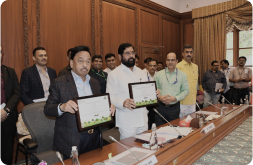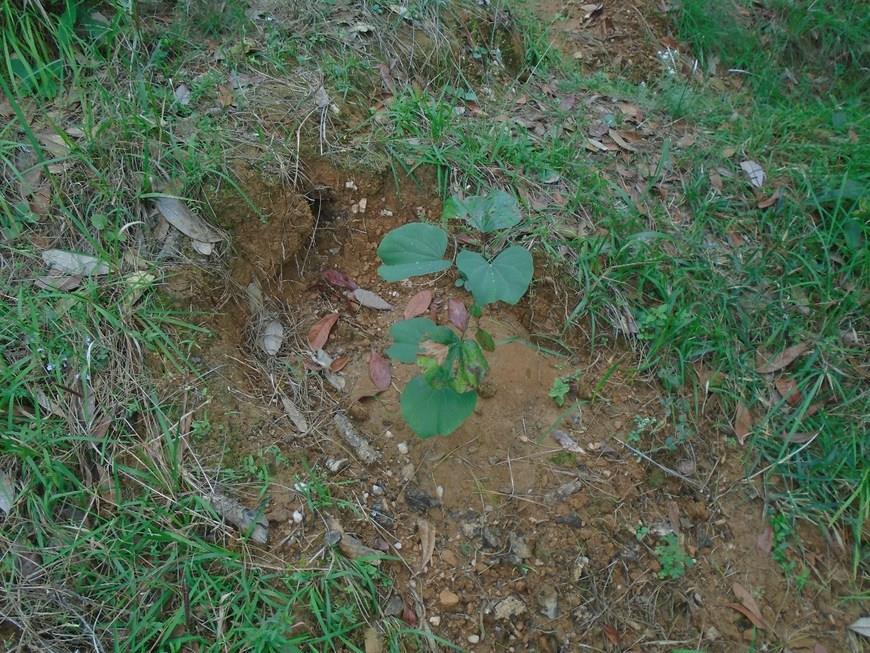










Project Target
0% Remaining
400,000
Trees Planted out of 400,000 Trees

Project Location:
The tree plantation project is implemented in 17 villages of Nainital and 6 villages of Almora in Uttarakhand, India.
Project Aim
SDG
Uttarakhand is home to India’s oldest forest management system - Van Panchayats. These are powerful bodies of villagers living on forest fringes who have been entrusted with the responsibility of managing and protecting forest areas since 1921. According to the India State of Forest Report 2019[1], at present there are 12,167 Van Panchayats in the State which manage an area of 7,32,688 hectares of forest. They are also in charge of safeguarding the region’s biodiversity, which includes rare, threatened, and endangered plant species, orchids, medicinal plants, and a variety of other animals and birds.
To support Van Panchayats in the Kumaon hills of Uttarakhand, conserve their forests, help them sustainably manage the forest resources, and protect the rich Himalayan biodiversity, we have introduced this project that involves planting trees and working closely with the local communities.
An article on ‘Forests for People, the Planet and Climate’[2] says that, “Forest goods provide an important hidden harvest for rural populations, keeping many people out of extreme poverty. About 350 million people who live within or close to dense forests depend on them for their subsistence and income.” It further adds that, “This contribution is greater than that of wage labour, livestock, self-owned businesses or any other category aside from crops.”
Research by Niyati Naudiyal and Joachim Schmerbeck[3] states that, for generations, these communities have relied on forest-based produce for their livelihood. Even with a relative increase in accessibility to the mountains, most of the local rural population continues to practise traditional forest centred livelihood practices, primarily due to poverty, unemployment, and lack of alternatives.
You can find a great variety of trees in the Himalayan Mountains, ranging from tropical dry deciduous forest in the foothills to alpine scrub near the timber line. However, in the last decade, heightened human activity in the Himalayan region has led to significant deforestation.
According to WWF[4], “The conversion of forests for agriculture and exploitation for timber, fodder, and fuelwood threaten the biodiversity in this region. Charcoal production in low-elevation areas and intensive grazing at higher elevations also threaten forests. The need for firewood is not only a burden for nature, but also for people.”
This has, in turn, triggered soil erosion in the hills, contributing to heightened flood risks in the plains and accelerated silting in rivers. Research conducted by the Department of Botany in Nainital[5] suggests that, the rise in human settlements along the oak forest area, along with practices such as lopping, felling, and occasional fires spreading from adjacent pines, have reduced the oak forest cover.
Forest fire is one of the major disasters in the forests of Uttarakhand. It adversely affects the indigenous and endangered species of flora and fauna. A journal on Himalayan Ecology and Environment[6] suggests that chir pine forests are mainly responsible for the spread of forest fires. In India, this species covers an area of 8900 sq.km. Chir pine is rich in resin content. While this makes it an economically valuable species, the same property makes it highly inflammable and vulnerable to forest fires. Through this tree plantation project, we support the planting of local tree species since they are compatible with the local ecosystem and have a higher likelihood of surviving due to their non-invasive character.
In this tree plantation initiative, we have included species like Amla (Phyllanthus emblica), Banj (Quercus leucotrichophora), Bakian (Melia azedarach), Bhatula (Desmodium tiliaefolium), Bhimal (Grewia optiva), Majena (Salix alba), Kanol (Bauhinia purpurea), Kachnar (Bauhinia variegata), Padam (Prunus cerasoides), Tej pata/ Dalchini (Cinnamomum tamala), Jamun (Syzygium cumini), Pangar (Aesculus indica), Ratanjot/ Sakina (Indigofera linifolia), Himalayan mulberry/ Shahtoot (Morus serrata), Tillonj (Quercus floribunda) and Ringal (Chimonobambusa falcata).
The trees are planted with the knowledge that the area is home to a diverse range of wildlife and rural communities and that planting trees must provide for their needs in terms of food, shelter, and commercial purposes. For instance, when mature, tree species like Bhatula, Padam, Kachnar, and Kanol are planted because of their vivid colours which draw a variety of birds, animals, and insects, while white willow and majuna are planted because of their therapeutic qualities. Himalayan Mulberry is planted for multifarious purposes-its leaves are used for feeding silkworms, the timber is used for furniture and agricultural implements, and the fruit (also known as shahtoot) is a popular fruit relished by locals and also used for sale to supplement their income.
The project aims to shift attention back to the Van Panchayats, who have experienced several difficulties and changes over the years. We think that locals have the most intimate knowledge of their forests, and by working closely with them, we hope to create a plantation effort that generates employment for these communities and enhances the local flora and fauna of the area.
With respect to forest-related issues, women are often excluded from the decision-making process. For the purpose of empowering them and reducing their reliance on the Van Panchayat for fodder and other forest products, our projects involve a large number of women working on our plantation sites.
The tree plantation initiative involves planting multipurpose local species, with an emphasis on their numerous socio-environmental benefits.
These trees will fulfil the requirement of fodder, fuel wood, and NTFPs for the local communities residing in the area. Additionally, we frequently engage with local communities to generate awareness about how they can utilise these resources to boost their livelihood and improve the environmental condition of the region.
Our commitment extends beyond planting trees. The Trees+ project allows us to create a holistic development. The project is intended to be implemented in the 23 villages of Nainital and Almora district in Uttarakhand.
We have implemented measures such as contour terraces, recharge ponds to prevent soil erosion and enhance soil fertility of the forest land. The construction of 25 recharge ponds/percolation pits has improved moisture regime for the new saplings & natural regeneration, enhanced discharge of the downstream spring, and reduced drudgery for women.
This initiative has facilitated the adoption of sustainable agricultural practices to improve yields and reduce environmental impact. We provide training and resources to the farmers on sustainable farming practices, agro-processing, and other income-generating skills. We facilitate access to markets for local produce, promoting fair trade, and creating sustainable value chains.
We aim to empower girls through education, particularly focusing on those from underprivileged backgrounds. We extend comprehensive support to girls in grades 9 to 12, recognising the pivotal role education plays in their lives. By covering tuition fees, providing school uniforms, and essential supplies, we alleviate financial burdens on their families, allowing these girls to concentrate on their studies without any hindrance. Furthermore, we emphasise the broader significance of girls' education, advocating for its long-term benefits within communities. Alongside academic assistance, we prioritise imparting essential life skills and offering career guidance. Through mentorship and networking opportunities, we assist them in identifying potential career paths and facilitate connections with external organisations and institutions for further education or vocational training.
Our Trees+ initiative is committed to fostering a supportive environment where girls can thrive academically and personally, laying the foundation for their future success and contributing positively to society.
[1] India State of Forest Report (2019). Uttarakhand, Volume II.
[2] The World Bank (2020). Forests for People, the Planet and Climate.
[3] Naudiyal, N., & Schmerbeck, J. (2018). Linking forest successional dynamics to community
dependence on provisioning ecosystem services from the Central Himalayan forests of Uttarakhand.
Environmental Management, 62(5), 915-928. doi: 10.1007/s00267-018-1087-5.
[4] World Wildlife Organisation - Eastern Himalayas - Facts.
[5] Shahi, C., Sharma, A., Bargali, K., & Bargali, S. S. (2014, January 1). EFFECT OF DISTURBANCE GRADIENT ON FOREST FLOOR BIOMASS IN NATURAL FOREST ECOSYSTEMS IN AND AROUND NAINITAL.
[6] Bargali Himanshu, Singh Pradeep and Bhatt Dinesh. ROLE OF CHIR PINE (PINUS ROXBURGHII
Social Impact of Growing Trees
Community Engagement
Tree planting initiatives often involve local communities, which can lead to greater community cohesion.
Ecological Education
Provides opportunities for community members, especially children, about the importance of environmental sustainability.
Urban Beautification
Trees contribute to the aesthetic enhancement of urban areas, making cities more pleasant and liveable.
Climate Resilience
By improving green cover, tree planting helps make communities more resilient against climate impacts like heatwaves.
Employment Creation
Planting trees creates employment for local community members like planting and maintenance, administrative roles, and more long-term jobs in management.
Wildlife Habitat
Trees provide critical habitats for various species of wildlife. Enhancing tree cover helps preserve biodiversity, which can be an ecological boon for local communities
Copyrights @ 2025 All rights reserved by Pangea EcoNetAssets Pvt Ltd.